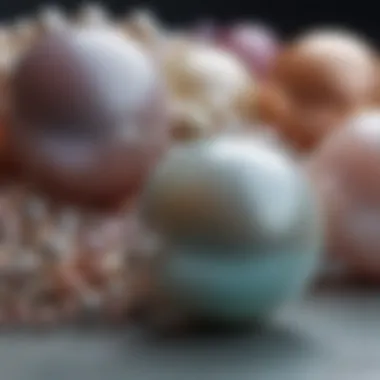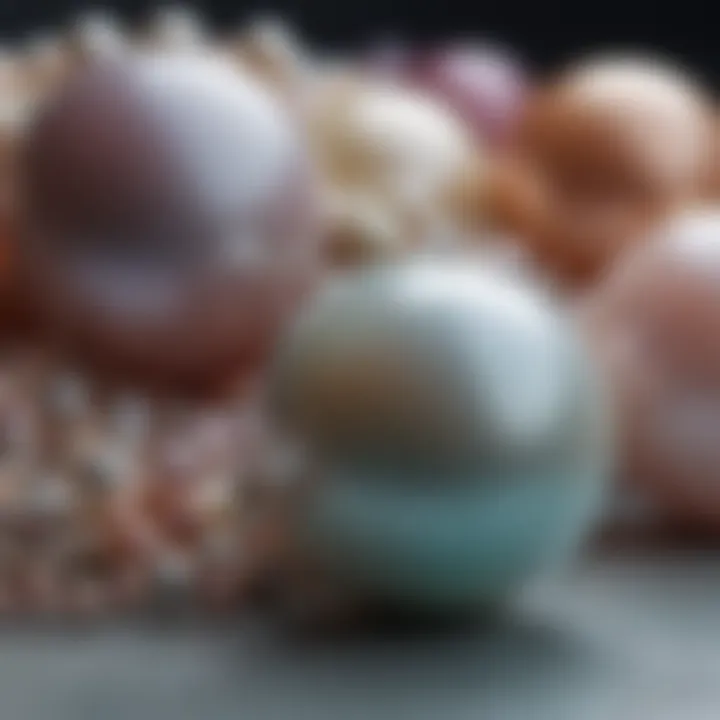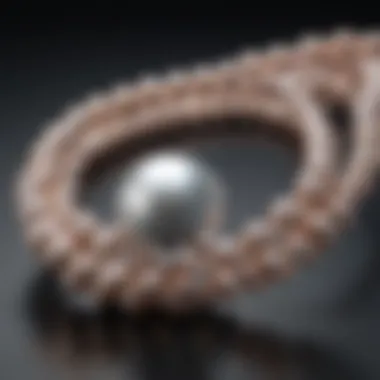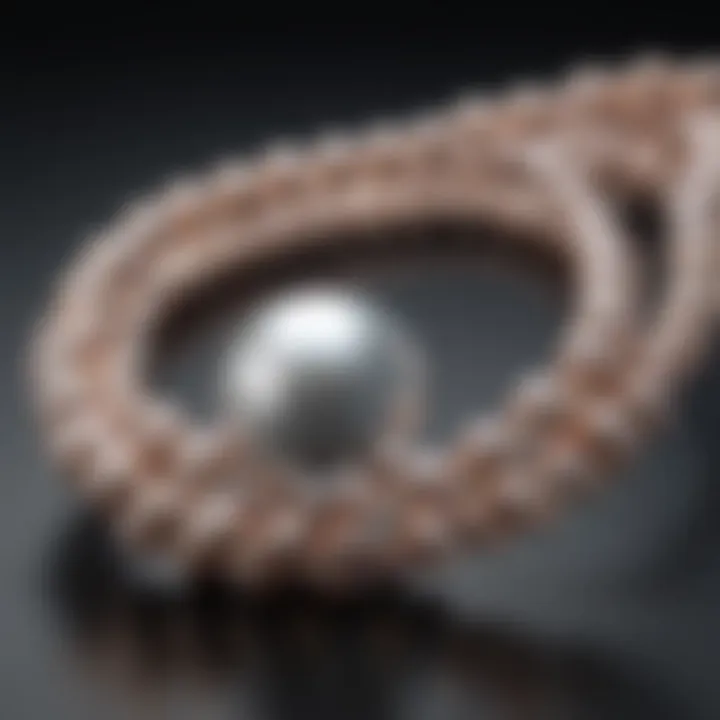Exploring the Color Spectrum of Real Pearls


Intro
Real pearls are among the most esteemed natural gems, prized not only for their beauty but also for their intriguing color spectrum. Each pearl's hue tells a story, influenced by a variety of factors during its formation. Understanding these elements sheds light on their significance in the enchanting world of jewelry.
The color of a pearl is not merely an aesthetic feature but a complex interplay of environmental and biological factors. This article examines the nuances of pearl coloration, detailing the scientific and cultural impacts that color variations imprint on the jewelry market. By investigating the genesis of these colors, we aim to enrich both enthusiasts and professionals with a deeper comprehension of pearl characteristics.
Key Findings
Summary of the main results
- Natural Variations: Real pearls exhibit a rich color palette. The most common colors include white, cream, pink, and black, but they may also present shades of blue, green, and gold.
- Influence of Factors: Several factors affect pearl coloration, including species of mollusk, water temperature, and the presence of certain minerals.
- Market Significance: The color of pearls plays a vital role in their valuation in the jewelry market. Rare colors, such as deep blue or vivid gold, command higher prices.
Significance of findings within the scientific community
The study of pearl color offers insights not only into mollusk biology but also into environmental influences that affect aquatic life. Marine scientists and gemologists alike find these studies valuable, as they may inform conservation efforts and sustainable pearl harvesting practices.
Implications of the Research
Applications of findings in real-world scenarios
Understanding the color spectrum of pearls can inform jewelers and retailers in their inventory decisions. This knowledge can lead to better marketing strategies that highlight unique pearl colors.
Potential impact on future research directions
Future research could explore the genetic factors influencing color production in pearls. Additionally, studies might investigate how climate change and pollution affect pearl quality and diversity.
"The beauty of a pearl is deepened by understanding what makes each one unique, including its vibrant colors."
By diving into the complexities of real pearl colors, we unearth the compelling stories behind their beauty, contributing to a more informed appreciation within the jewelry market.
Prologue to Pearl Colors
Pearls are unique among gemstones, celebrated not just for their luster and beauty but also for their diverse color spectrum. Understanding the color of pearls is crucial for numerous reasons, especially when delving into their appeal in fine jewelry. Color can influence not only aesthetics but also symbolic meanings, cultural values, and market demand. Hence, the topic of pearl colors becomes significant in the context of both jewelry enthusiasts and industry professionals.
As one explores the different colors natural pearls exhibit, one begins to appreciate how these variations correlate to the conditions under which they formed. This awareness further informs decisions when purchasing pearls, as well as add depth to the conversation about their cultural significance. Through this section, we will outline the basic definitions and significance of natural pearls and explore the reasons why color plays such an essential role in their value and desirability in the market.
Defining Natural Pearls
Natural pearls occur when oysters or other mollusks create a protective response to irritants, primarily grains of sand or parasites. During this process, layers of a substance called nacre are secreted, gradually building up around the irritant over time. The end result is a pearl, which can vary in size, shape, and—most importantly—color. It is crucial to distinguish natural pearls from cultured ones, as the latter are formed with human intervention, where an irritant is intentionally introduced.
Natural pearls are somewhat rare due to the declining population of many mollusk species, making them highly sought after in jewelry. Their formation process results in unique characteristics, which include but are not limited to their color variation. This natural diversity is what adds a distinct charm to each pearl, offering a unique piece of nature's artistry to its admirers.
Why Color Matters in Pearls
Color is a defining feature of pearls, affecting their beauty and value. Variations in hue arise from various factors, such as the species of mollusk, nacre thickness, and environmental conditions. Therefore, understanding pearl coloration involves appreciating how these elements interplay during formation.
Each color carries its own associations and meanings. For example, white pearls are often seen as classic and timeless, while pink and lavender offer a more modern touch. Additionally, unusual colors like gold or black can be more valuable due to their rarity. Buyers often associate these colors with specific emotions or intentions, which can influence purchasing decisions.
Pearl color affects market trends as well. Jewelers often emphasize specific colors to meet consumer demand, which continues to evolve. Staying abreast of these trends helps both buyers and sellers understand the dynamics of the pearl market better. Ultimately, color not only enhances aesthetic appeal but also plays a crucial role in the economic landscape of pearls.
The Color Spectrum of Pearls
The color spectrum of pearls is a fundamental aspect of this remarkable gem. Understanding these colors offers insight into both their natural beauty and their appeal in the jewelry market. Pearls come in a wide array of hues, each with distinct characteristics. The colors are not just a visual treat; they reflect various factors that influence the formation and market valuation of pearls. In this section, we will explore some of the most common and unique colors of pearls, highlighting their significance and variations.


Common Colors: White and Cream
White and cream pearls are the most easily recognized. These colors signify purity and elegance. They are often favored for bridal jewelry and classic pieces. The luster of these pearls can vary, impacting their value and appeal.
- Natural White Pearls: Typically formed in various mollusks, but most commonly associated with the Pinctada species.
- Cream Variants: Cream pearls often have subtle shades, which may include hints of yellow or gray. These nuances can increase their attractiveness.
Both white and cream pearls are versatile and can complement a range of outfits. Their demand remains high, and they are often considered an essential addition to any pearl collection.
Shades of Pink and Rose
The pink and rose pearls capture the essence of femininity and charm. Their warm colors can range from soft pastels to deeper hues. Pink pearls often come from the Pinctada Maxima oyster. The differing intensity and tone of these pearls can significantly affect their market value as well.
- Shades: Soft pink appears delicate, while deeper rose can evoke a sense of luxury.
- Popularity: Pink pearls have surged in popularity, often accentuated in modern jewelry designs.
These colors are seen as rare gems, frequently sought after by collectors who appreciate their unique appeal.
Golden Pearls: A Unique Category
Golden pearls are highly sought after in the jewelry market. They primarily originate from the Pinctada Maxima and have an exceptional sheen. These pearls can range from light champagne to rich, deep gold.
- Distinctive Features: Gold pearls stand out due to their inherent rarity. They often symbolize wealth and opulence, making them a popular choice for high-end jewelry.
- Variations: Depending on the environment and the oyster, the exact hue of golden pearls can vary, creating unique pieces in both natural and cultured forms.
Their striking appearance ensures that they maintain a high value, appealing to discerning buyers.
Black Pearls: Misconceptions and Realities
Black pearls are often misunderstood. Many believe they exclusively come from dark mollusks, but this is not entirely accurate. Black pearls can exhibit a spectrum of colors, including green, blue, and even purple undertones. These pearls typically originate from the Pinctada margaritifera oyster. Their unique color can create a cumulative effect that intrigues collectors and enhances their desirability.
"The color of black pearls is deeply influenced by the iridescence of the nacre, leading to vibrant visual impacts that can change with light."
- Cultural Symbolism: In some cultures, black pearls symbolize mystery and elegance.
- Market Misconceptions: Despite the misconceptions, black pearls can vary significantly in value based on their rarity and specific shade.
Understanding these nuances can lead to better purchasing decisions and greater appreciation for this unique pearl category.
Less Common Colors: Lavender and Blue
While white, cream, pink, and gold dominate the pearl market, lavender and blue pearls present a fascinating deviation. Their rarity makes them unique, enhancing their market value significantly.
- Lavender Pearls: Often identified as a more subdued hue, these pearls can come with subtle undertones of pink or gray. Fans of unconventional jewelry often gravitate towards these pieces.
- Blue Variants: Although rare, blue pearls are highly coveted. Natural blue pearls are largely found in specific regions, adding to their exclusivity.
Both colors carry a sense of individuality, making them appealing to those seeking pieces that differ from traditional pearl colors.
The color spectrum of pearls is not solely about aesthetics. It serves to heighten the appreciation for this gem's intricate processes and market dynamics. Understanding these elements can profoundly affect how individuals view and utilize pearls in jewelry.
Factors Influencing Pearl Color
The color of pearls is not merely a decorative feature; it is a complex attribute shaped by various factors. Understanding these influences is crucial for anyone seeking to appreciate the aesthetic and intrinsic value of pearls. The interplay of natural processes determines the spectrum of colors observed in real pearls. The following sections will dissect these influential elements, namely nacre thickness, the species of oyster or mollusk, and environmental conditions during growth.
Nacre Thickness and Luster
Nacre, or mother-of-pearl, is the layer of aragonite and conchiolin that forms the bulk of a pearl. Its thickness significantly affects both the color and luster of the pearl. The iridescent quality of pearls, known as luster, is derived from the way light interacts with the nacreous layers.
Generally, thicker nacre results in a deeper color and a more brilliant luster. This thickness allows for better light reflection and refraction, enhancing the pearl's visual appeal. A pearl with thin nacre may appear dull and less colorful, regardless of its hue. As dealers often inform buyers, evaluating nacre thickness is one strategy to gauge a pearl's quality.
Species of Oyster or Mollusk


The type of oyster or mollusk that produces a pearl plays a pivotal role in determining its color. Each species has unique characteristics that influence final outcomes. For example, Akoya pearls, produced by the Pinctada fucata oyster, are primarily white or cream with subtle overtones. In contrast, Tahitian pearls derive from the Pinctada margaritifera, producing dark colors ranging from greenish to slate blue.
Notably, the color variety among different species goes beyond aesthetics. Each type's habitat, feeding habits, and biological makeup contribute to unique coloration. This aspect underscores the biological diversity within the world of pearls, which collectors often seek out when searching for distinct items.
Environmental Conditions During Growth
Environmental conditions significantly shape pearl color as well. These factors include water temperature, salinity, and depth, which can all affect the pearl's development. For instance, warmer waters may promote faster growth and can influence the overall pearling process.
Moreover, impurities or variations in the surrounding ecosystem can cause unique coloration. Factors such as the presence of certain minerals in the water can alter the pearl's shade. For example, the presence of copper can lead to greenish tones, while minerals like iron may impart hues of brown.
To summarize, understanding the factors influencing pearl color provides deeper insight into their appeal and value in the jewelry market. Each factor, from nacre thickness to mollusk species and environmental conditions, is interconnected. Grasping this complexity enables enthusiasts and professionals alike to appreciate the artistry of real pearls.
Cultural Perceptions of Pearl Colors
Understanding the cultural perceptions surrounding pearl colors offers significant insights into the value and desirability of these unique gems. Different cultures imbue various colors with distinct meanings and attributes, influencing personal and collective preferences in pearl selection. Recognizing how color impacts cultural expressions enhances the appreciation of pearls beyond mere aesthetic qualities. Furthermore, insights into symbolism help consumers make informed decisions aligning personal values with their purchases.
Symbolism in Different Cultures
In various cultures, pearls carry rich symbolic meanings which often correlate closely with the colors they display. For example, in many Western cultures, white pearls are traditionally associated with purity and innocence. This is why they are commonly chosen for bridal jewelry, representing the bride's purity on her wedding day.
On the other hand, black pearls, particularly those sourced from Tahitian oysters, are often seen as symbols of sophistication and mystery. In some Pacific Island cultures, these pearls are highly revered and carry significant cultural weight, reflecting the depths of the oceans they come from and the rich heritage of the inhabitants.
In Asia, specifically in China, the color red is linked to good fortune and joy. Therefore, red or pink pearls may hold specific appeal as symbols of prosperity. There is a growing interest in such hues, illustrating how cultural narratives around colors inflect consumer interest and choice in pearl jewelry within that region.
Pearl Colors in Fashion
The interplay between pearl colors and fashion is both dynamic and impactful. Fashion trends often dictate which colors are in vogue, significantly influencing the market for pearl jewelry. For instance, current trends may favor pink or lavender pearls, compelling designers to integrate these shades into their collections.
Prominent designers have begun to showcase pearls of non-traditional colors, positioning them as essential accessories across a spectrum of outfits. Luxury brands like Mikimoto and Chanel have expanded their offerings to include not just classic white but also vibrant shades, reflecting a broader shift towards incorporating unique elements in personal style.
Moreover, seasonal collections frequently embrace color palettes and styles that resonate with the trending themes of the time. Unusual shade combinations and the juxtaposition of pearls with other materials have become more common, pushing the boundaries of traditional fashion norms.
As consumers become more aware of the cultural weight behind certain colors, their choices in pearl jewelry also reflect personal narratives and identities, shaping fashion discourse.
"Pearls are no longer just for grand occasions; they are symbols of individuality and modern style across cultures."
The End
Market Value and Rarity
The market value of pearls is a multifaceted subject that intertwines aspects of rarity, color, and demand. Understanding how different hues impact pricing is essential for anyone interested in pearls, whether for investment, collection, or mere appreciation. The rarity of a pearl color can dictate its worth on the market. Some colors, such as black or gold, tend to be far less common than others, leading to higher prices.
In the gem market, rarity is often the ultimate determinant of price. A pearl’s color can affect not only its aesthetic appeal but also its cultural significance. For example, gray or blue pearls can fetch higher prices due to their uniqueness and lower availability.
Price trends fluctuate based on current societal preferences and changing fashion trends. Consideration of seasonal patterns and market demand offers further insight into potential investments. Pearls, unlike many other gemstones, can display a spectrum of tones stemming from the same species of mollusk. Here, the influence of cultural perceptions cannot be ignored. Different cultures may ascribe various values to specific colors. Thus, a deep understanding of this aspect is crucial for someone involved in this sector.
"Value in pearls is often dictated not just by their physical attributes but also by the emotions and stories they convey through their color."
A clear insight into pricing differentials is necessary. High-quality pearls in rare colors can command premium prices. Meanwhile, more common colors may only attract a fraction of the cost.
Pricing Differentials Among Colors
Pricing differentials among pearl colors reflect the complex interplay between rarity and desirability. Here’s a layered look at how colors impact the pricing of pearls.


- White Pearls: These are regarded as classic and often the most widely available, resulting in relatively lower pricing.
- Pink and Rose Pearls: These have gained popularity and can vary in price significantly based on tone intensity.
- Golden Pearls: Typically considered luxurious, these pearls are rarer than white or pink, often leading to higher price points in the market.
- Black Pearls: Though black pearls can sometimes be common, the unique overtones can elevate value considerably.
- Lavender and Blue Pearls: These shades are less commonly found, often resulting in higher prices due to their scarcity.
This differentiation exemplifies how demand correlates with rarity, underscoring that prices are not simply a reflection of quality but rather a complex equation of various factors.
Trends in Pearl Jewelry Preferences
As consumers become more discerning about their choices, trends in pearl jewelry continuously evolve. Market preferences vary, influenced by fashion, cultural shifts, and individual tastes.
Some notable trends include:
- Sustainable and Ethical Sourcing: Today’s consumers prioritize ethically sourced pearls, impacting the demand for specific colors. Brands that promote sustainable practices in pearl cultivation often face heightened interest.
- Customizable Jewelry: There is a growing inclination toward personalized jewelry pieces that allow buyers to choose specific pearl colors, enhancing the market for rare shades.
- Focus on Unique Colors: Earrings, necklaces, and bracelets featuring less common colors are becoming popular, leading to a premium on those hues.
- Technology Integration: Online platforms have made it easy for consumers to explore various color options, influencing purchasing decisions significantly.
Overall, the interplay of pricing differentials and trend shifts highlights the dynamic nature of the pearl market. As tastes and societal values shift, so too do the opportunities for investment and appreciation in pearls.
Synthetic vs. Natural Pearls
The dichotomy between synthetic and natural pearls merits careful consideration. Understanding the distinction influences purchasing decisions and informs trends within the jewelry market. Natural pearls emerge from the natural defense mechanisms of mollusks, while synthetic pearls are created artificially through human intervention. This distinction impacts various factors, including texture, luster, and overall aesthetic appeal.
Natural pearls are quite rare and can take years, even decades, to form. The intricate process, which starts when an irritant enters a mollusk, activates the secretion of nacre. Each layer of nacre contributes to the pearl's luster and depth. Conversely, synthetic pearls, such as those produced by companies like Majorca or Mikimoto, can be manufactured in a fraction of the time. They sometimes replicate the physical properties of natural pearls but may not capture the unique imperfections that characterize genuine natural specimens.
Understanding Synthetic Pearl Creation
Creating synthetic pearls involves several methods, with one of the most common being the use of a nucleus, typically a bead, surrounded by layers of nacre. This process simulates the natural pearl formation yet allows for control over various parameters, such as color and size. This precision means that synthetic pearls can be produced in a wide variety of hues, making them popular among consumers seeking specific colors without the unpredictability associated with natural pearls.
- Cultured Method: This involves implanting a nucleus in an oyster or mussel to induce nacre secretion.
- Coating Method: This includes coating glass or plastic beads with a layer of nacre to which we can add color enhancements.
- Color Treatments: Synthetic pearls may also undergo color enhancement treatments to achieve desired shades that are not possible through natural processes.
Color Differences Between Synthetic and Natural Pearls
The color of pearls can vastly differ based on their origin. Natural pearls typically exhibit subtle hues, often speaking to their natural growth environment, while synthetic pearls can showcase a broader spectrum of colors.
- Natural Pearls: Commonly display tones influenced by the mollusk species. For example, Akoya pearls usually have white or cream shades, while Tahitian pearls can range from black to green.
- Synthetic Pearls: Generally more vibrant and consistent in color. They can achieve bright pinks, blues, and other shades that are not typical for their natural counterparts.
In terms of value perception, natural pearls tend to command a higher market price due to their rarity and organic formation. Synthetic pearls, while affordable, can sometimes be looked down upon for lacking the "genuine" quality of their natural peers. Despite this, many appreciate synthetic pearls for their vibrant colors and lower price points, thereby catering effectively to a diverse consumer base.
In summary, the exploration between synthetic and natural pearls highlights critical differences in formation, value, and color. Both offer distinct advantages, and understanding these factors aids consumers in making informed choices.
Finale
In summarizing the intricacies of pearl coloration, we reinforce the significance of understanding this topic both in a natural and market context. The color of a pearl is more than mere aesthetics; it reflects phenomena that occur within the oyster or mollusk, influenced by various intrinsic and extrinsic factors. By grasping these elements, one appreciates the uniqueness of each pearl and the profound beauty they possess.
Recap of Key Insights
The exploration into the color spectrum of real pearls has revealed critical insights:
- Diversity of Colors: Pearls can exhibit a wide range of colors including white, cream, pink, golden, and black, each with a unique appeal.
- Factors Influencing Color: The hue of a pearl is shaped by nacre thickness, the specific species of mollusk, and environmental conditions during its growth.
- Cultural Significance: Different cultures value pearl colors differently, attributing various meanings and uses in jewelry.
- Market Trends: Color variation impacts market value, often dictating pricing differentials based on rarity and demand.
- Synthetic Alternatives: The emergence of synthetic pearls poses intriguing questions about authenticity and value perception in the market.
Understanding these factors not only enhances appreciation for natural pearls but is also essential for making informed purchases in jewelry.
Future Outlook on Pearl Research
As the fields of marine biology and gemology continue to advance, we anticipate several future pathways in pearl research. Key areas include:
- Genetic Studies: New techniques in genetics may clarify how specific mollusk breeds determine pearl color, leading to innovations in pearl farming.
- Environmental Impact: Given the fluctuating environmental conditions worldwide, research may focus on how climate change affects pearl formation and coloration.
- Market Dynamics: The ongoing shift towards ethical and sustainable sourcing will likely influence both natural and synthetic pearl markets.
These future insights promise to deepen our understanding of pearls, solidifying their position not just as decorative items, but as products of nature deserving of careful consideration and study.
"Understanding pearls is crucial, as it reveals their hidden beauty shaped by nature itself."
(adapted from studies in marine biology and gemology)
By continuing to explore these dimensions, stakeholders from jewelry enthusiasts to researchers can better appreciate the importance of pearls and their vibrant spectrum of colors.







